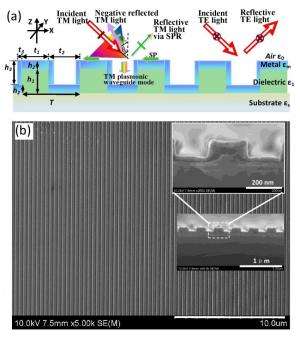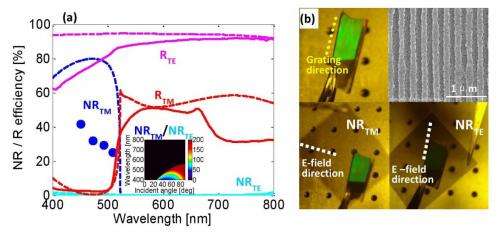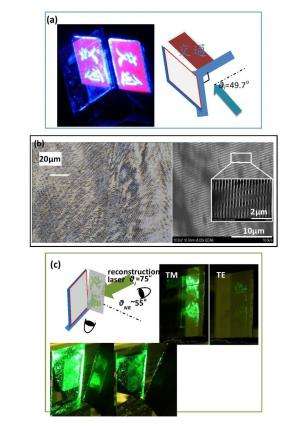October 24, 2014 feature
Flatland, we hardly knew ye: Unique 1-D metasurface acts as polarized beam splitter, allows novel form of holography

(Phys.org) —Traditional three-dimensional (3-D) plasmonic metamaterials with metallic structures – artificial materials that exploit coherent delocalized electron oscillations known as surface plasmons produced from the interaction of light with metal-dielectric materials – exhibit unique electromagnetic properties not found in natural materials, such as extraordinary transmission beyond the diffraction limit, efficient light-harvesting ability, plasmonic color filtering, and the ability to control the reflection or transmission direction of a light beam. However, they are difficult to fabricate, have a narrow usable bandwidth due to their resonant character, and exhibit low optical efficiency due to the inherent metal absorption. While two-dimensional metasurface structures have been proposed in an attempt to address these functional limitations, they still require complex designs and sophisticated fabrication procedures.
Recently, scientists at Shanghai Jiao Tong University proposed a unique method for controlling photons with a 1-D metasurface that, by integrating diffraction, waveguide, and plasmonic effects, is fundamentally distinct from 2-D or 3-D methods. The 1-D metasurface they presented, based on bilayered metallic nanowire gratings, behaves as an ideal polarized beam splitter that produces highly anisotropic strong negative reflection for transverse-magnetic (TM) light and efficient reflection for transverse-electric (TE) light. (Anisotropy is the property of being directionally dependent, as opposed to isotropy, which implies identical properties in all directions.) Moreover, by combining this feature with the fringed structure of a hologram, the researchers demonstrated a higher-security anti-counterfeit metasurface holograph, that can be decoded only by TM light.
Dr. Zhicheng Ye discussed the paper that he, Dr. Jun Zheng and their co-authors published in Scientific Reports with Phys.org. A key factor is simplifying the metastructure to a one-dimensional metasurface using a bilayer metallic nanowire grating. "Designing three- or two-dimensional nanoantenna arrays can modify the optical wavefront with spatially-varying phase response," Ye tells Phys.org. "However, complex designs and sophisticated fabrication procedures are required. Simplifying the metastructure to one dimension is preferred for applications and large-scale production, but the structure that allows tunable parameters is limited. Therefore, the main challenges to achieve specific functions using bilayer metallic nanowire grating involve exploring and utilizing the intrinsic properties of surface plasmon waveguide, combining these with the diffraction characteristics of grating, and finding proper parameters."
Relatedly, Ye continues, using bilayer metallic nanowire gratings with nano-slits as 1-D metamaterials to realize both polarized negative reflection and reflection carries its own challenges. "Thus far, the dielectric or metal beam splitters based on gratings usually have narrow working spectrum and angle range. On the other hand, these studies have typically focused only on transmission and reflection properties – but polarized diffraction has not been considered," he explains. "We proposed the bilayer metallic nanowire gratings with nano-slits as 1-D metamaterials to realize polarized negative reflection for transverse-magnetic light and reflection for transverse-electric light, with a broad range of useable wavelengths and incident angles." The key point is that metasurface beam splitting does not rely on a resonant coupling mechanism, thereby enabling a broad range of useable wavelengths and incident angles, with flexible tunability in operation. "The main challenge was determining how to simultaneously realize broadband, angle-insensitivity and high polarization extinction ratios. Our research shows that, the grating pitch should be large enough to ensure a broad working spectrum; the slit should be wide enough to insure that transverse-magnetic light can be refracted strongly, but also thin enough to suppress TE refraction efficiently; and the proper slit height should significantly enhance the polarization extinction ratio."
Optical performance is not the only issue the scientists faced: The fabrication challenge is that in order to obtain high extinction ratio for both negative reflection and reflection, the ratio between the silt-width and pitch is always smaller than ½ – that is, the exposure condition for laser interference lithography (LIL) should be optimized. "The issue will be more challenging as the slit-refractive index increases, because the slit width should be further reduced to achieve the cut-off effect," Ye notes. "Smarter design of the grating structures is needed for the high extinction ratio of both reflection and negative reflection, especially for a very wide waveband device."
The third challenge was combining the intrinsically fringed structure of a hologram and the anisotropic character of metasurface beam splitter. "In a hologram, the interference fringes usually have random direction, pitch, duty cycle, and depth," Ye points out. "Therefore, to combine the hologram and beam splitter, photoresist processing and recording parameters should be well-designed in order to get deep and narrow slits for guaranteeing high-efficiency of TM light and inhibiting TE diffraction simultaneously. Otherwise, extinction ratios for both negative reflection and reflection will be lowered." Moreover, since a laser hologram is usually recorded on photoresist film in the form of fringes caused by two-beam interference, the patterns are typically fringed structure with pitch decided by the wavelength and angle between the interference beams. "To obtain maximum diffraction efficiency," Ye explains, "the fringes should be deep enough – but the contradiction is that deepening photoresist fringes causes slit width to increase, which in turn weakens anisotropy."
The researchers leveraged a range insights and techniques to address these challenges. "In our one-dimensional metasurface, the key point was fully combining the intrinsic properties of dielectric-metal-dielectric slit and the diffraction characteristics of grating, and finding the proper parameters to meet the required waveband," Ye recounts. "At the same time, the starting point of our research is physically as simple and fundamental as the description in classic optics textbooks that for diffraction to exist in a grating, the light should be able to enter into the slits. Therefore," he explains, "by considering the fact that in metal-insulator-metal waveguides TM mode is always supported while TE mode is dissipative in sub-wavelength size, we intuited that TM diffraction can be made to break the diffraction limit – corresponding to vector diffraction optics – while for TE light the diffraction should disappear without 'sensing' the slits, corresponding to geometrical optics." The demonstration of the hypothesis not only convincingly reveals a new way to control photons, but also gives a very clearly physical image for the transition between scalar optics (where the optical phenomena can be described by scalar diffraction) and nano-optics (where the wavelengths are much larger than the size and pitch of the resonant units so the diffraction is therefore absent.)

"Our technique is quite different from that generally employed in metamaterials research, where very fine nano-size resonators are often required to achieve a specific function, and where the diffraction effect – while more efficient and robust in either periodical or aperiodical structures – is rarely considered," Ye points out. Our study gave us the profound perspective that we can gain knowledge by utilizing long-established basic mechanisms to alleviate the difficulty of nano-optical device fabrication, rather than by pursuing very complex metastructures without considering cost and application practicality."
Summarizing their approach to creating a novel polarized beam splitters, Ye says that a dielectric grating was fabricated by nano-imprinting or laser interference on a silicon or glass substrate. "The grating was subsequently coated with ten nanometers of metal film by E-beam evaporation," he tells Phys.org. "In order to narrow the slits to restrain the TE diffraction, the deposition was optimized to make the metal film conform to the dielectric grating as far as possible. In doing so, the metal deposited on the side walls of the grating lines helped reduce the slit width."
The paper discusses how metasurface beam splitting enables a broad range of useable wavelengths and incident angles with flexible tunability in operation by not relying on a resonant coupling mechanism. "For the metasurface polarized beam splitter with TM negative reflection/TE reflection, the upper limit of the working wavelength is determined by the pitch, and the lower limit is decided by the slit width. Thus," he explains, "by choosing appropriate grating pitch and slit width, the polarized beam splitting can be achieved. For further improving the extinction ratio, it needs to optimize silt and metal thickness." Therefore, the device is flexible tunability in a wide range of spectra which is more robust than those beam splitters using resonant mechanism in which grating height, refractive index, pitch and duty circle must be precisely designed.
"Relatedly, our metasurface holograph – decodable only by transverse-magnetic polarized light –consists of a bilayer metal grating which ensures that only TM light can be diffracted. This means that the metasurface hologram can only be decodable by TM light, and the real image is reconstructed in the reflection side with the negative first order refraction." Periodically constructed metamaterials, in which permittivity (a measure of how an electric field affects, and is affected by, a dielectric medium) and permeability (the degree of magnetization that a material obtains in response to an applied magnetic field) have simultaneous negative values, creating negative refraction (a dimensionless number that much light is bent when entering a material.

In addition to the 1-D metasurface applications discussed in the paper – displays, holograms, and laser optics – Ye mentions several others:
- Compact reflective mirrors for laser cavities where the polarized output is required to meet the coherence for optical communication or laser interference
- Diffractive gratings in optical spectrometers, where the TM diffraction efficiency is stably high in a wide waveband with high angle resolution since the pith is only several hundred nanometers, which has several advantages: as a reflection element it provides a range of benefits, such as allowing the controlling circuit to be placed below the reflective surface, and more advanced integrated circuit technology becomes available when the substrate materials are not limited by their opaqueness; and a folded light path wherein the input and output light beam share the same physical space, which offers a desirable compact arrangement
- As a novel plasmonic beam splitter, it can also be implemented in integrated optics devices for communication: TM light is diffracted into one waveguide and TE light is reflected into the other, allowing the two beams to be manipulated for further use
There are also long-term implications of a higher-security anti-counterfeit plasmonic hologram produced by adding the additional criterion of what Ye refers to as the "simple example" of polarization dependence demonstrated in the paper. "The greater enlightenment is that plasmonic effects can be used for higher-security anti-counterfeits," he confirms. "In fact, not only the polarized diffraction-change of the brightness but also the polarized reflection-change of the color can be utilized as new criterions to judge a hologram." Yet another advantage of the plasmonic anti-counter faking is that optical resonance can be well-engineered by the thickness of metal films, slit width and grating pitch, substantially increasing the cost and difficulty of fakery – especially for a complex pattern with several values of pitch, metal thickness and direction of the metallic nanowire grating. "In a word," Ye notes, "we open a new door for the application of metasurface devices in anti-counter faking."
Moving forward, in the near future the scientists are planning to create a theoretical 1-D metasurface model that presents a quantitative effective refractive index to analyze structural properties, thus facilitating further device design. "In the long-term," he adds, "for polarized beam splitting we plan to increase the waveband and extinction ratio for both reflection and negative reflection simultaneously by using a more delicate nanowire arrangement. Moreover, in addition to our current emphasis in anti-counter faking, we'll be looking at other applications, including integrated optics, spectrometers and laser cavities."
Another important innovation that the researchers might consider developing is combining actively tunable metasurfaces with other techniques, such as liquid crystals and electrowetting. "Tunability will enable metasurfaces to be applied to displays, optical storage and communications," Ye tells Phys.org. "Also, we're considering if the optical properties we've observed can be extended to other frequency spectra – for example, the terahertz range, since doing so may help us to build terahertz devices. In closing, Ye says that other areas of research, such as high-field laser physics, might also benefit from their study.
More information: Highly anisotropic metasurface: a polarized beam splitter and hologram, Scientific Reports 4, 6491 (29 September 2014), doi:10.1038/srep06491
Journal information: Scientific Reports
© 2014 Phys.org



















